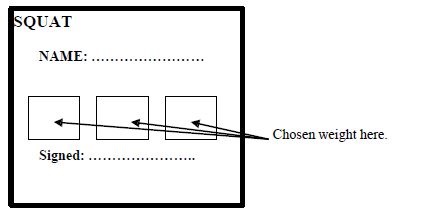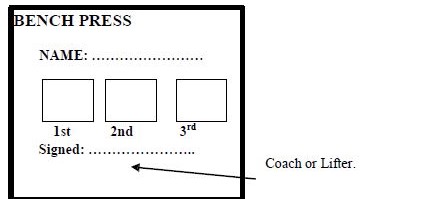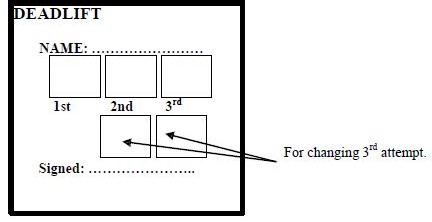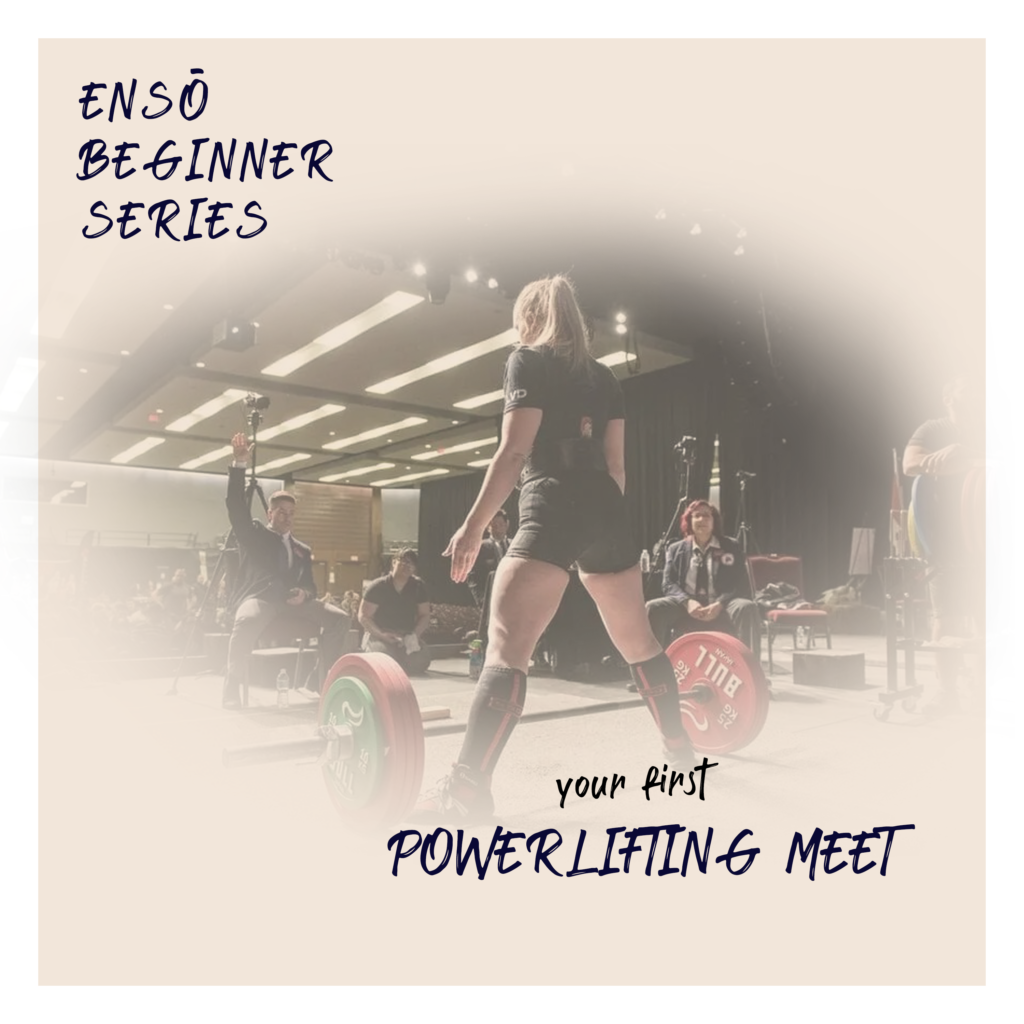Introduction
This guide is written for newbies competing in an IPF-sanctioned powerlifting meet. We’ve distilled our experiences into an easily readable piece in the hope that you may pick something up that will make your powerlifting meets more fulfilling. At the end of each section, the critical tips are consolidated for ease of reference. Along the way, some intermediate-level tips are thrown in for good measure—this would also be an excellent refresher for those who haven’t competed in a while.
Basic Flow of a Meet
Registration
Before every meet, all athletes and coaches would have to sign an indemnity form and complete the necessary registration. As such, we recommend that you arrive at the competition venue 15 minutes before your weigh-in time in order to settle down and complete your registration. Rushing creates unnecessary stress.
Weigh-in & Equipment Check
IPF weigh-ins are held 2 hours before the first lift. You should find your name on the weigh-in list and your allocated lot number. Lifters are each allocated a randomly generated lot number to determine the weigh-in sequence. Weigh-ins are conducted in ascending lot number order and will be held for 1.5 hours. In case you do not fulfill the weight requirement, you may re-weigh yourself within this time period.
The weigh-ins are held in an room with an official of the same gender. Lifters must weigh themselves either in their undergarments or nude. To begin, provide a form of identification e.g. NRIC, passport or Singpass. After completing your weigh-in, provide the official with your openers, and receive your attempt cards. The attempt cards have to be signed either by yourself or by your coach/handler. We recommend that you sign all the attempt cards ahead of time.



Image taken from IPF rule book
Equipment check will usually be held shortly after the weigh-in, or concurrently with the weigh-in. All equipment must be approved as stated on the IPF Approval List. Non-IPF approved equipment will be rejected. Equipment must also be in good condition; officials may disqualify equipment deemed to be in poor condition i.e. holes in equipment, broken equipment.
Mandatory Competition Attire:
- Shoes – Shoes with a rubber outside sole lining are not allowed.
- Socks – Long socks covering your whole shins (goes up to the bottom of the knees) are mandatory on deadlifts.
- Undergarment – To prevent cheating via supportive equipment, undergarments have specific requirements as follows:

- T-Shirt – Has to be made of cotton, with short sleeves.
- Lifting Singlet – Also known as a non-supportive lifting suit
Optional Competition Attire:
- Knee Sleeves
- Belt
- Wrist Wraps
- Medical Tape – To be worn around the thumbs. Maximum of two layers
Tips:
- Arrive early to orientate yourself. Missing the weigh-in will push you to the back of the queue. Absentees after the first round of weigh-ins may be subject to disqualification.
- Equipment check is usually done concurrently with the weigh-ins. If you have a higher lot number, check your equipment first to maximise time for refeed and warm-up.
- To speed up equipment check, pack them all in a separate compartment/bag for ease of access.
- Bring your isotonic fluids/water into the weigh-in room and consume immediately after weigh-in if you did a water cut. Hydration is more critical than satiety. If you are competing for the first time, do not calorie/water cut.
- Sign and write your name on every attempt card ahead of time.
Lifting Session
As stated above, IPF weigh-ins are held 2 hours before the first lift begins. I.e. if your weigh-in is held at 8:00 AM, the first lift begins at 10:00 AM.
A lifting session may consist of 1 or 2 groups, and one group may consist of up to 14 lifters. Each group within a session will contain roughly an equal number of lifters. In most, if not all cases, you will not be split up from your fellow competitors in the same weight class and age category.
| Lot No. | No. | Name | Age Cat. | Weight Class | ||
|---|---|---|---|---|---|---|
| SESSION 1 | GROUP A | 52 | 1 | Billy Batson | Sub-junior | Men's U59 |
| 10 | 2 | Wally West | Sub-junior | Men's U59 | ||
| 2 | 3 | Lex Luthor | Open | Men's U59 | ||
| 5 | 4 | Dick Grayson | Junior | Men's U66 | ||
| 8 | 5 | Jason Todd | Junior | Men's U66 | ||
| 45 | 6 | Tim Drake | Junior | Men's U66 | ||
| 32 | 7 | Barry Allen | Open | Men's U66 | ||
| 42 | 8 | Arthur Fleck | Masters 1 | Men’s U66 | ||
| GROUP B | 57 | 1 | Bruce Banner | Open | Men's U83 | |
| 1 | 2 | Peter Quill | Open | Men's U83 | ||
| 31 | 3 | Steve Rogers | Open | Men's U83 | ||
| 24 | 4 | Shang-Chi | Open | Men's U83 | ||
| 28 | 5 | Bucky Barnes | Open | Men's U83 | ||
| 15 | 6 | Thor Odinson | Open | Men's U93 | ||
| 9 | 7 | Otto Octavius | Open | Men's U105 | ||
| 19 | 8 | THANOS | Open | Men's U120 |
Group A will complete all 3 attempts (all the lifters will complete their first attempts, followed by second, and then third), followed immediately by group B. The lifting order within each round is determined by the lifters’ submitted attempts, following the principle of a rising bar (the bar must be loaded progressively during each round). In the event of two lifters having the same weight, the lifter with the lower lot number drawn at the weigh-in will lift first.
You may change your openers once, and it can be higher or lower than your previously submitted opener. If you are in Group A, you may submit the change up to 3 minutes before the first lift. If you are in Group B, you may submit the change up to 3 attempts from the end of the previous group’s last round (3rd attempts) (roughly equivalent to ~3 minutes). Any attempt changes are to be done at the Technical Table, who are usually seated beside the competition platform. These deadlines will be announced by the officials, so do look out for it. Take note that you are not allowed change your 2nd and 3rd attempts after it is submitted, except for the last attempt of your deadlift.
On the deadlift, you have 2 extra chances to change your last attempt. From page 24 of the IPF Technical Rules Book, “The change of the weight may be higher or lower than the lifter’s previously submitted third attempt. However, these are only permitted provided that the lifter has not been called to the bar already loaded to his previously submitted weight by the speaker.” Additionally, the change also cannot break the principle of a rising bar, and lot number orders. In other words, if another competitor has been called onto the platform and he has 210kg loaded on the bar, you cannot change your attempt to be below 210kg. You may change your attempt to 210kg, provided that your lot number is higher than the competitor who just lifted the 210kg. Otherwise, following the principle of a rising bar, you have to load above 210kg.
After each of your attempts, you must submit your next attempt within 1 minute to the technical table. Failure to do so will lead to 2 possible outcomes, based on your previous attempt:
- Successful lift: your next attempt will be automatically increased by 2.5kg from your previous attempt.
- Unsuccessful lift: your next attempt will remain the same.
If there are 2 groups within a session, a 10-minute break will be given between each discipline. However, if there is only 1 group within a session, a 20-minute break will be given instead.
Tips:
- Let your coach/handler inform you early on your order of lifting to give yourself enough time to get mentally ready, wrap your wrists, and/or chalk your hands/back.
Rules of the Lifts
Visual and verbal commands are given to the lifter before, during and after the performance of each attempt by the chief referee. Failure to comply will automatically render the attempt unsuccessful. Here are the verbal commands for each discipline:
| Squat | Bench Press | Deadlift |
|---|---|---|
| “Squat” | “Start” | “Down” |
| “Rack” | “Press” | |
| “Rack” |
Read the IPF Technical Rules Book 2021, in particular pages 7-9 as they outline the reasons for failure for each lift as determined by the referees/jury. Here are some common pitfalls we observe in new lifters:
| Squat | Bench Press | Deadlift |
|---|---|---|
| Failure to comply with command/Downward movement of the bar | ||
| Failure to hit depth - “top surface of the legs at the hip joint is lower than the top of the knees” | Not holding the bar motionless for the “Press” command | Using the thighs to support lifting the bar. Also known as hitching/ramping |
| Not locking out the knees and/or hips | Shifting/raising of the feet, butt and/or head anytime between the “Start” and “Rack” commands | Not locking out the knees, shoulders and/or hips |
Tips:
- Practise your lifts within the commands leading up to the meet.
- After executing the squat and bench press, hold in place to avoid missing the “Rack” command. The spotters will guide you back after the “Rack” command is given, so you don’t have to worry.
- Perform the lifts to the required standard by the referees, not your own.
Timing Your Warm-Up
Warm-ups are essential to get your body primed to lift heavy weights on the platform. More often than not, your warm-ups can make or break your performance. Planning your warm-ups will help keep your stress level to a minimum on meet day. There are some things that you should consider as you plan:
- Amount of time you need for general warm-up.
- No. of warm-up sets leading up to your opener.
- Amount of time you need to rest in between your warm-up sets.
- Time of first lift.
- Number of lifters before your position in the group.
As a rule of thumb, treat the duration of every lifter’s attempt as 1 minute, and count backwards from your position in the group until you get the approximate time that you should begin your general warm-up. Here are some of the ways you can roughly plan your warm-up timings:
| Scenario 1: GROUP A 1. 30 minutes e.g. foam rolling 2. 5 sets 3. 5 minutes 4. 9:00 AM 5. 4 lifters |
Scenario 2: GROUP B 1. 15 minutes e.g. barbell complex 2. 6 sets 3. 4 minutes 4. 2:30 PM 5. 6 lifters + 10 lifters in the first group |
|---|---|
| - First lift is at 9:00 AM and you have 4 lifters before your lift. Therefore, your first attempt starts roughly at ~9:04 AM. - Multiply 5 warm-up sets by 5 minutes of rest time to get 25 minutes, and deduct this time from ~9:04 AM. You start your first warm-up set at ~8:39 AM. - Deduct 30 minutes from this time to get the start time of your general warm-up at ~8:09 AM. |
- The positions of the lifters for the second group are usually not arranged according to their openers yet, so manually count the number of lifters who have a lower opener than you. - First lift is at 2:30 PM and there are 10 lifters in the first group. Multiply this number by the number of attempts each to give 30 minutes. Hence, the second group should start at approximately ~3:00 PM. - You have 6 lifters before your lift, therefore your first attempt starts roughly at ~3:06 PM. - Multiply 6 warm-up sets by 4 minutes of rest time to get 24 minutes, and deduct this time from ~3:06 PM. You start your first warm-up set at ~2:42 PM. - Deduct 15 minutes from this time to get the time of your general warm-up at ~2:27 PM. |
Once you complete your 1st/2nd attempt and submit your next attempt, wait until the end of the round for the sequence to reshuffle according to increasing attempts.
Tips:
- Warm-ups on meet day should not be significantly different from warm-ups in training. For example, if you do not usually take a 20kg increment from your last warm-up to your top set, you should not plan for a 20kg increment from your last warm-up to your opener on meet day.
- Keep an eye on the movement of the group, there may be changes to the positions of the lifters.
- When in doubt, buffer for more time. Do not get caught up in the exact timing of your warm-up. You will likely share the rack with other lifters, and it is extremely difficult to follow your warm-up timing to the letter. Be flexible, and keep calm throughout. Adjust your warm-up scheme and timing along the way as needed to best prepare you to lift on the platform.
Attempt Selection
In choosing the weights for your own attempts, we have the following guidelines. This is not a hard-and-fast rule, but it is a good guideline to see how your attempts will look like on the meet day. If you have a coach, discuss the attempt selections with him/her and plan accordingly!
| Indicators | Recent RPE | Previous 1RM | Expression |
|---|---|---|---|
| 1st Attempt | 7 ~ 8 | 90% ~ 92.5% | “a weight you can do even on the worst day” |
| 2nd Attempt | 8 ~ 9 | 95% ~ 97.5% | “slightly below or at your personal best” |
| 3rd Attempt | 9 ~ 10 | 100% ~ 105% | “a weight that makes you anxious yet confident” |
When in doubt, play safe. This is your first meet, so don’t feel any pressure to force yourself to hit big PRs that is clearly out of reach. It is more important that you set yourself up for success down the road.
Tips:
- Don’t be afraid to be slightly more conservative with your opener. Start off strong and gain the momentum you need to set yourself up for success. It is not where you begin, but where you end that matters.
- Remember to submit your next attempt within the 1 minute countdown.
- Plan your attempts ahead of time. Plan for both ‘good’ and ‘bad’ days.
- A good lifter has the ability to adapt to various situations. Prepare to the best of your ability, but you have to adapt for unplanned situations on meet day to stay focused.
Meet Day Nutrition
As we are neither nutritionists or dieticians, the following should not be taken as nutritional advice. The following suggestions are based on our experiences and opinions. For the food you consume after weigh-ins, you do not want to deviate too much from what you usually eat before training or on a daily basis. However, the amount should not be too much that you feel sluggish and experience “food coma”. As a powerlifting meet generally run pretty long, we would suggest bringing along some snacks as well. Your snacks should preferably be something that is pure/high in carbohydrates as it is the fastest to digest and give you energy.
We list some of our favorite refeed food below. Once again, disclaimer in full force here!
| Meal (after weigh-in) | Yakun / McDonald’s | Tori Q | Chicken Rice |
|---|---|---|---|
| Snack #1 | Doritos | Honey | Mitsuya Tasty Biscuit Sticks |
| Snack #2 | Wang Wang | Wang Wang | Banana |
| Drink #1 | Coconut Water | Coconut Water | Milo |
| Drink #2 | Monster Energy Drink | Water | Water |
Tips:
- Bring enough food and drink, as the meet may run up to 4-6 hours.
- Bring 1 meal to consume after weigh-ins, and snacks to munch on throughout the day.
- Familiar, comfort food works best.
- Avoid oily and greasy foods.
- Resist the temptation to try something new to “increase your performance through sports nutrition”. You may get a stomachache.
- Pace your caffeine intake to reduce the ‘crash’ midway through the meet.
Closing Tips
- Remember the commands and cues for each lift.
- Please do not try anything new e.g. tweaking of form on meet day, eating something you don’t usually eat, etc.
- Remember to submit your next attempt within 1 minute.
- Stay calm and have fun.
P.S. Most of these apply for other federation powerlifting meets as well, but some rules may differ. Some of the most common differences include:
- 24-hour weigh-in instead of 2-hour weigh-in
- Feet do not need to be fully planted on the floor for the bench press
- Rules on attempt changes
To be safe, always double-check the rules of the respective federations before competing.
Further questions? Feel free to contact us at [email protected].
Appendix
Sample Packing List
| Miscellaneous | Equipment |
|---|---|
| Identification Card | Long Socks |
| Pen | Competition Singlet (non-supportive) |
| Baby Powder | Shoes |
| Wet Wipes/Small Towel | Cotton T-Shirt |
| Earphones | Undergarments (non-supportive) |
| Extra Set of Clothes | Normal Length Socks |
| Refeed Food | Belt |
| Water Bottle | Knee Sleeves |
| Pre-workout | Wrist Wraps |
| Jacket | Warm-Up Equipment (such as resistance bands) |

